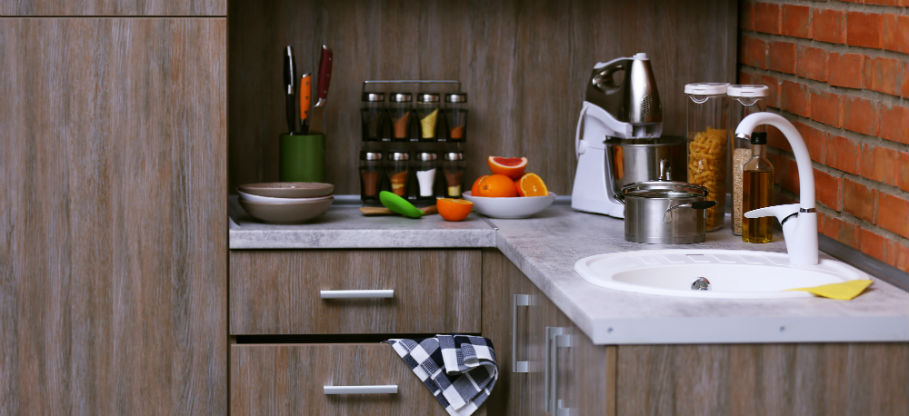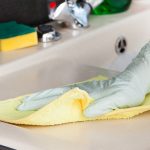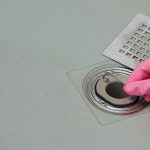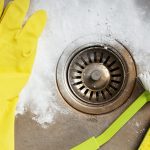
One of the most unsightly things to see in any house is a clogged drain causing a pool of standing water with debris swimming in it. The bathroom drain would most likely be clogged up with hair, or an occasional hair product cap. The kitchen drain, however, is another story.
- Why is your kitchen drain clogged?
- What to try first
- How to unclog a kitchen sink drain with standing water?
- How to prevent your drain from blocking again
- How to keep your kitchen sink drain smelling fresh?
If you:
- Are struggling with a clogged kitchen drain;
- Are looking for tips on how to tackle it yourself;
- Want to know how to prevent it from happening,
Then read on!
Grease and food particles can easily cause a serious blockage that would halt your daily routine at home. Luckily, the Fantastic Services team is on the case and will explain how to unclog a kitchen sink drain with standing water.
Reasons Your Kitchen Drain is Clogged
- Food waste. Even if you have a waste disposal unit under the sink, it’s advisable not to throw any food waste, no matter how small. Things like tea leaves or coffee grounds don’t even break down, so they can easily clog up the drain.
- Grease. Many believe that grease, fat, and oils shouldn’t cause a blockage. However, they can build up on the inside of the pipe and capture other food particles. Also, grease is very hard to clear out.
- Soap. Traditional soap bars are made with grease or animal fat. Because of that, soap can leave a hard residue on the inside of the pipes.
- Mineral buildup. If the water in your area is hard, there would be some mineral buildup in your drain. With time, it will cause a blockage. Mineral buildup is very hard to remove so you will need professional help.
- Small objects. From wedding rings to bottle caps and just about anything can get stuck in the drain and cause plumbing problems.
What to Try First
Before you call the plumber, check if it’s not something you can fix yourself. Here are a few quick tips you can try to unclog the drain, before calling a professional.
- Boiling water. The easiest thing you can do is pour boiling water in the drain and let it break down the blockage. If the water doesn’t drain and just sits in one place, then your problem is more complicated than you think and you’ll need to do something else.
- Waste disposal unit. If you have a waste disposal unit, run it and see if the clog clears up. Check if it’s running correctly. Maybe, this caused the problem the whole time.
- Homemade solution. You can buy a product from the local supermarket to pour in the drain but bear in mind that all of them are made from the same things you have in your kitchen – mainly salt, baking soda, and the like. You can buy one of those products or you can try making one yourself. Here’s how to do it:
Homemade Baking Soda and Vinegar Solution
- Prepare your materials. What you need is two cups of baking soda and two cups of vinegar. The more acidic is the vinegar, the better.
- Pour the first baking soda cup down the drain. Empty the entire cup of baking soda. It might be hard, but try to coat all the insides of the drain while doing so.
- Pour the first cup of vinegar. Empty the entire cup of vinegar and cover the drain with an old rag. You should hear a fizzing sound from the chemical reaction between the two ingredients.
- Repeat. One time won’t be enough. Repeat with the second cups of vinegar and baking soda. Just like the first time, pour the baking soda first and then, the vinegar. Cover the drain with a rag again and listen to the fizzing.
- Hot water down the drain. After 30 minutes, boil a kettle full of water and slowly pour it down the drain. The clog should clear up.
If the clog isn’t cleared, the water would overflow in the sink. Observe it for a minute and see if it drains slowly or doesn’t drain at all. If it’s the former, it’s worth repeating the same homemade solution method again to see if there’s any progress. If it’s the latter, you will have to resort to using some plumbing tools.
Need a professional?
Find a professional plumber today.
- We’re certified:

How to Unclog a Kitchen Sink Drain with Standing Water
If the homemade potions failed you, it’s time to pull up your sleeves and take out the home maintenance tools.
Time needed: 45 minutes.
Here is how to plumb a sink:
- Clear all debris.
As you can guess, you probably didn’t switch off the water immediately after you noticed that it wasn’t draining, so you’re now stuck with a sink full of water and waste. Before trying to resolve the problem, you have to clear up the debris. Chances are, there are a lot of food particles covering the drain anyway. It’s advisable to wear rubber gloves while doing that. If you’re lucky, removing the waste by hand might be enough to let the water drain by itself. If not, proceed to the next step.
- Remove all standing water from the sink.
Pay attention to the water. Is it still, or is it draining slowly? If it’s the latter, you can leave it for an hour, until it drains by itself. If not, you’ll have to remove it yourself. Use a plastic cup or any other vessel to scoop the water and dispose of it away from the sink. Once the sink is clear, it’s time to unclog the drain. There are three tools you can use for that.
- Plunge the drain.
Find a plunger and place it over the drain so that the suction cup creates a vacuum. Push the handle in and out. This would move the blockage towards the plunger. Listen to the sounds coming from the drain. Once you hear the pipes sounding empty, you will know the blockage is cleared. Have patience when working with the plunger, as it usually takes some time before you get results.
- Remove the P-trap.
The P-trap is that curved part of the pipe beneath the sink. It can often get clogged up by food debris. In order to clear up the drain, you’ll have to remove the P-trap and rinse the pipe thoroughly. For that, you better know how to work with channel-type pliers. Place a bucket under the P-trap, because once it’s removed, it will spill a lot of water and trash.
- Try with a drain snake.
Sometimes the blockage is located farther down than the P-trap. In this case, you’ll need a tool, called a drain snake. Push the end into the drain and turn the handle, so the auger journeys down the pipe. Push until you feel resistance. Rotate the snake against the blockage, in order for the tip to attach to the clog. Then, pull the snake out. The clog should come out with it. Run hot water for a few minutes to clear the pipe.
Most homeowners have a plunger and channel-type pliers somewhere in the closet, however, the drain snake is a very specific tool, used by professionals. Few people have it at hand and it’s not cheap either. If your drain problem requires a drain snake, it’s advisable to call a professional plumber. Check this post to learn more how much plumbers charge.
How to Prevent Your Drain from Blocking Again
The best way to keep your drain from blocking again is reducing the amount of food waste that enters the drain to a minimum. To do that, before washing your dishes, dispose of any food leftovers in the rubbish bin, or even better – in a compost pile. If your plates are particularly greasy or oily, wipe them with a paper towel before washing.
Refrain from using traditional soap to avoid soap scum coating your drain. If this isn’t an option, make sure to pressure clean your drain on a regular basis to avoid buildup. Also, if you live in an area with hard water, you can install a water softener to avoid any mineral buildup.
How to Keep Your Kitchen Sink Drain Smelling Fresh
Sometimes, you might notice your drains are smelly, despite not being blocked. It could mean that there is some kind of organic buildup. The reason for this could also be the age of the pipes. Here’s what you can do about it:
Put a stopper plug on the drain and fill your sink with hot water. Add some dish soap in it and stir until you are certain none of it has deposited on the bottom. Then, remove the plug and let all the hot water run through the drain. Sometimes, this is enough.
Another way is to put ice cubes, coarse salt, and lemon peels in the grinder and let it do its job. The ice and salt scrub the sides for any food particles and the lemon peels would add a pleasant fresh aroma that might linger for a whole day.
Hire a professional
If you know how to plumb a sink, you won’t have any trouble to fix the problem yourself. But sometimes, you simply don’t have the time to spare for a tedious and frankly unpleasant maintenance task such as unclogging the kitchen sink drain. In these cases, you could always call a professional plumber to do the job for you.

Visit the main website for information about prices and service coverage by our handyman professionals in London.
Takeaways
- Food waste, grease and mineral build-up are some of the reasons your kitchen drain may be clogged.
- There are some homemade solutions you can try before resorting to professional help.
- If you don’t want to deal with unpleasant clogs, you need to prevent any food particles from going down the drain.
- Invest in helpful tools that help with unclogging, such as a plunger, a drain snake and channel pliers.
The best medicine for any home disaster is prevention. If you don’t want to ever deal with clogged drains, build a habit of not using the kitchen sink as a rubbish bin. Do regular inspections of your home’s pipe system and, of course, call a professional plumber nearby plumber when the problem is out of hand.
***
Have you ever had to unclog your kitchen sink? Tell us about your experience in the comments!
Image source: Africa Studio/shutterstock.com


